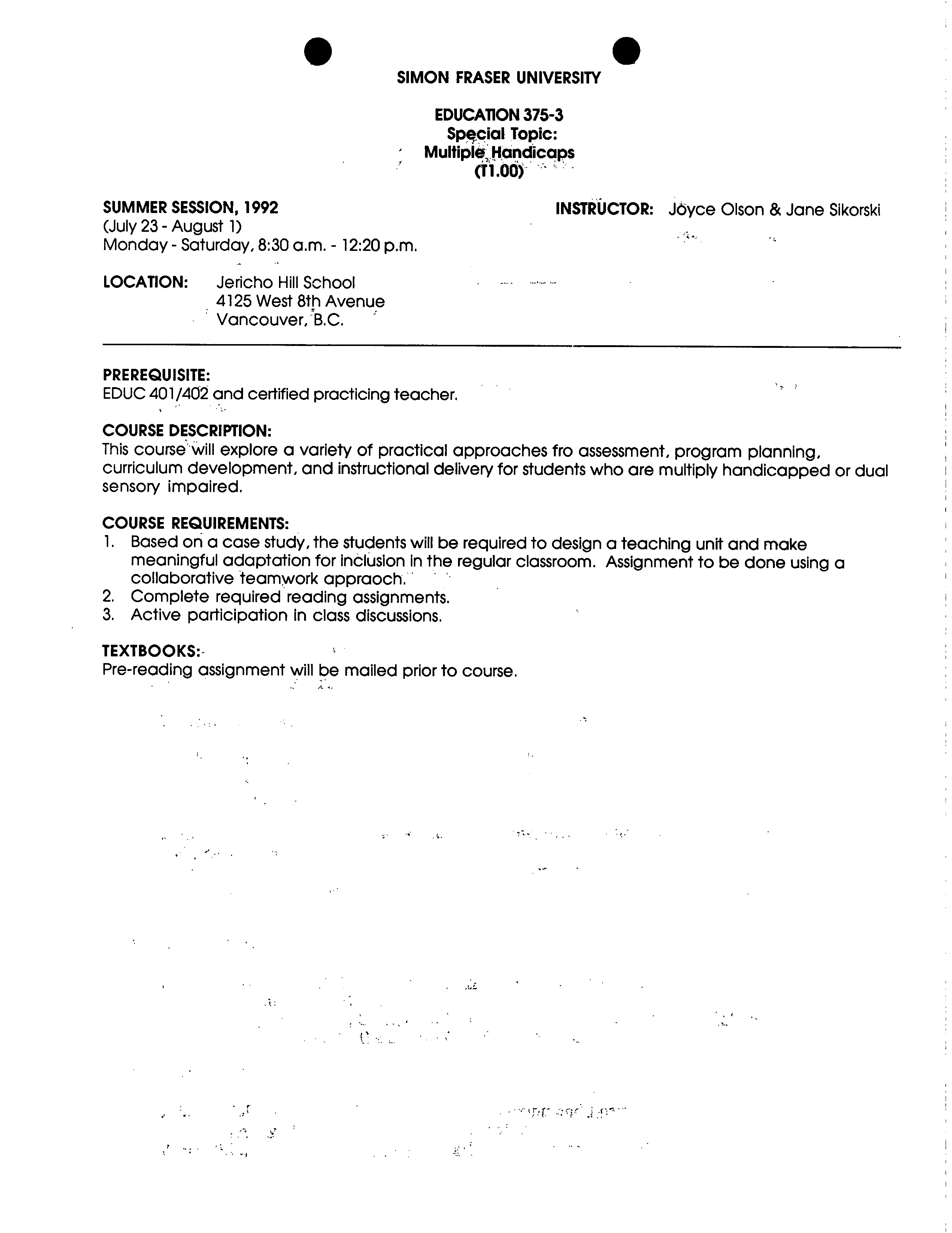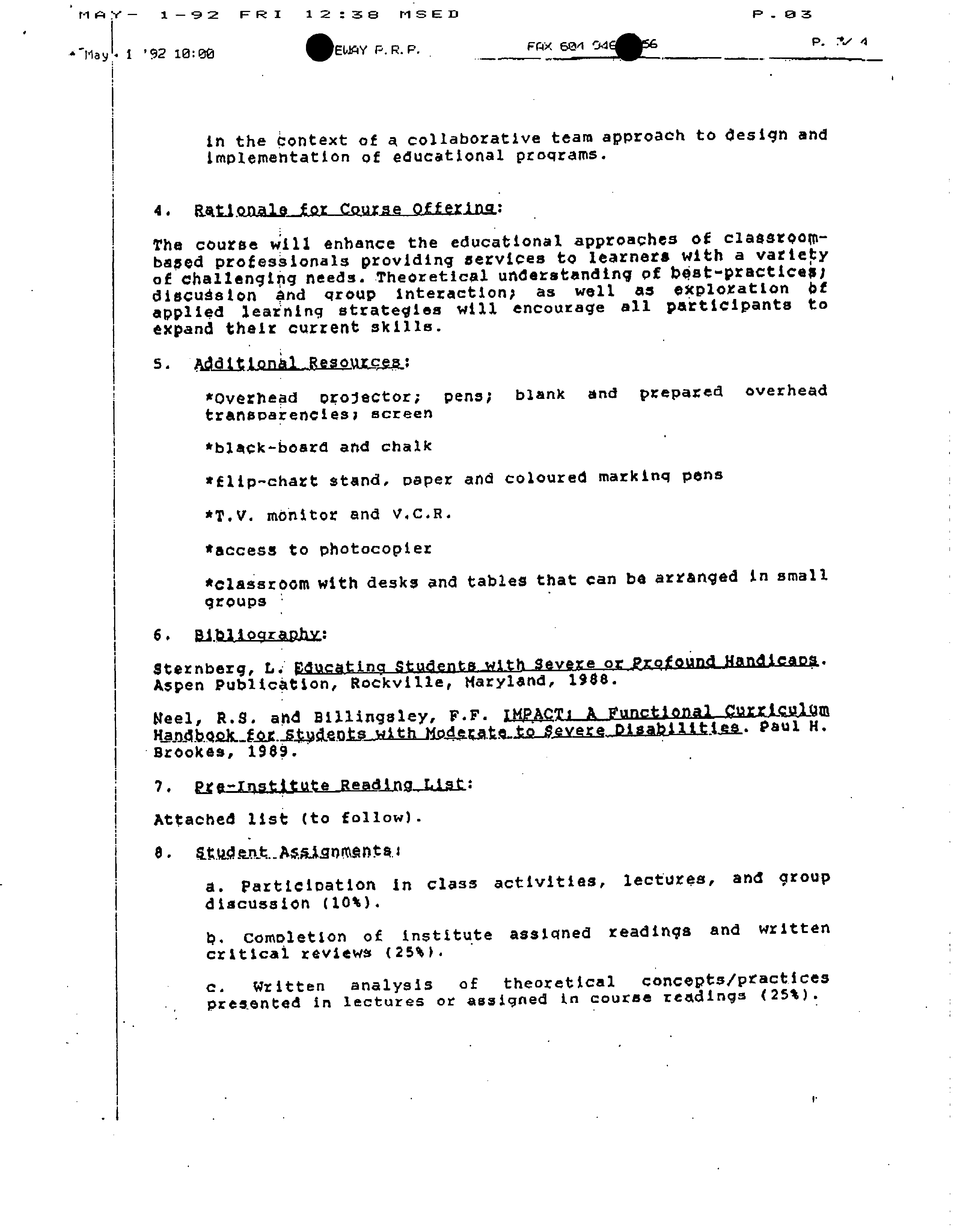.
?
?
SIMON FRASER UNIVERSITY
.
EDUCATION 375-3
?
SpciaI Topic:
?
Multiple. Handicaps
?
(Tl.00)
SUMMER SESSION, 1992
(July 23-August 1)
Monday - Saturday, 8:30 a.m. - 12:20 p.m.
LOCATION: ?
Jericho Hill School
4125 West 8th Avenue
Vancouver, B.C.
INSTRUCTOR:
JOyce Olson & Jane Sikorski
PREREQUISITE:
EDUC 401/402 and certified practicing teacher.
COURSE DESCRIPTION:
This coursewill explore a variety of practical approaches fro assessment, program planning,
curriculum development, and instructional delivery for students who are multiply handicapped or dual
sensory impaired.
COURSE REQUIREMENTS:
1.
Based on a case study, the students will be required to design a teaching unit and make
meaningful adaptation for inclusion in the regular classroom. Assignment to be done using a
collaborative teamwork appraoch
2.
Complete required reading assignments.
3.
Active participation in class discussions.
TEXTBOOKS:-
Pre-reading assignment will be mailed prior to course.
1 - 9 2 F R I 1 2 : ?
ris
E D
S.
ma
!o
?
'92 9:59
?
GTEUJY P.R.P.
j-
02
FRX 504-946- 6
?
- ?
-
o.c)
—
D
aJ:)Jf
eF'C7
TAX-UNIVBRBITY SPECIAL EDUCATION
?
SUMMER INSTITUTES
COURSE OUTt.NE
L.2-_of.ir.&L
?
?
Special Educ&tiOfl of Multi -handicapped
.
arid
?
Dual Sensory Impaired
Learners
Kathleen McGUnfl-Kim, WEd.
1.
The course will address theoretlCal and applied educational
practices relatina to the Inclusion of learners with
multi-
handicaps and dual sensory jmoairments
in the
reu3.ar school
settin. Current research approaches and direct service solutiOnS
will be explored to delineate "best practice' educational
etrateales for implementation in
fultIflClUsi0n
learning
environments. The impact on educators at the professional
training
arid preptatiOn
level will be considered as participants explore
their jriividual philosophical approaches in creating learning
experiences relevant to the
needs of all students.
A range of
ctrent regular education initiative* combined with speCial
eduatioi1 Otrateqles will provide the basis for developing an
enOmpássiflg educational model.
2. xLcaiLt
Introduction to Special Education beneficial but not required.
3.
Pct.y$:
Course ParticiDants will:
a.
Relate current educational
,
research in special education
to the needs of learners who are multi -handicap
p
ed or who have
dual senèorv imnairments.
b.
oractices
Explore
to determine
current
approaches
regular education
Back to top
which
and
allow
initiativeS
for inclusion
of
all learners in
the
educational program.
C. ?
Determine a range of support systems and services
?
(including other learners) available in the school and
community environment.
d.
Identify
relevant programming options which will enhance
inclusion
and
meet the real-life needs
of
learners who are
multi-handicapped or who have dual sensory Impairments.
e.
Examine ?
the ?
roles
?
o
?
professional
?
educators,
administrators, para_profe!i0flal5 support staff, and parents
1
•
1 A -( -
i1a9 ?
I
1-92 FR I 1 2 : 38 rISED
?
P -
'2 12: 00 ?
•EWlY P.R.P.
?
FAX*
in the context of a collaborative team approach to design and
implementation of educational proqrams.
4. UQJ1&_i9.LSsuL9e Off eriaa:
The course will enhance the educational approaches of classrOOm-
based professionals providing services to
learners
with a variety
of
challenging
fleeds. Theoretical uderstendiflq of be
at-practicesj
diecuaion and group interaction; as well
as
exploration Of
applied learning
strategies will
encourage all participants
to
expand their
current skills.
5.
*OverJed projector; pens; blank and prepared overhead
trans
p
arencies, screen
*b1k_board and chalk
*flipchart stand, paper
and coloured marking pens
*T.V. monitor and
V.C.R.
*access to photocopier
*classroom with
desks and
tables that can be
arranged in small
groups
6.
.j41joQa,gJl:
Sternberg, I.. Educating Students-With Severe
orrqOund Handicaps.
Aspen Publication, Rockville, Maryland, 1988.
Reel, R.S. and Billingsley, F.F. iMACQi A Punction.a1.LcJ.1i
Di
saki
It ?
Paul H.
BrOokes, 1989.
7.
Attached list (to
follow).
a.
a. #articioatIOfl in class activities, lectures, and group
discussion (lOt).
. com
p
letion of Institute ass
q
ned readings and written
critical reviews (25%).
C.
Written analysis of theoretical concepts/practices
presented
In lectures
or assigned in course reding5 (25%).
•riV - 1-92 FRI 12:Z59 rISED
-
(1
.
1 92 10:01
?
•EUJY V. R., P.
?
P..
d. Comoletion
of individual Droject consisting
ot development
of an individual
education plan
for a soecific leaner who is
multi -handicapped or dual sensory Impaired; and
ak
clanzocm
lesson olan which includes learning opportunities for the
soecial learner
in
the regular
clac5rOOJfl
(25%).
. Presentation in small group format
of
collaborative team
400roach to educational declsionma)clng for learners who ha'e
rultiplc handicaps (15t).
9. Dcriiij of StudentseQ.rnent nd Grading Pocedure:
Grad ir
q
accordin
g
to University grading scale on above
assignmenEe
as weighted
A. Su p
erior to flxcellent
2' Good to
Very Good
C- Acce
p
table to
Satisfactory
D Deviation
from
Acceptable
Standards
of Academic
Performance
F' Failure to Complete Course




